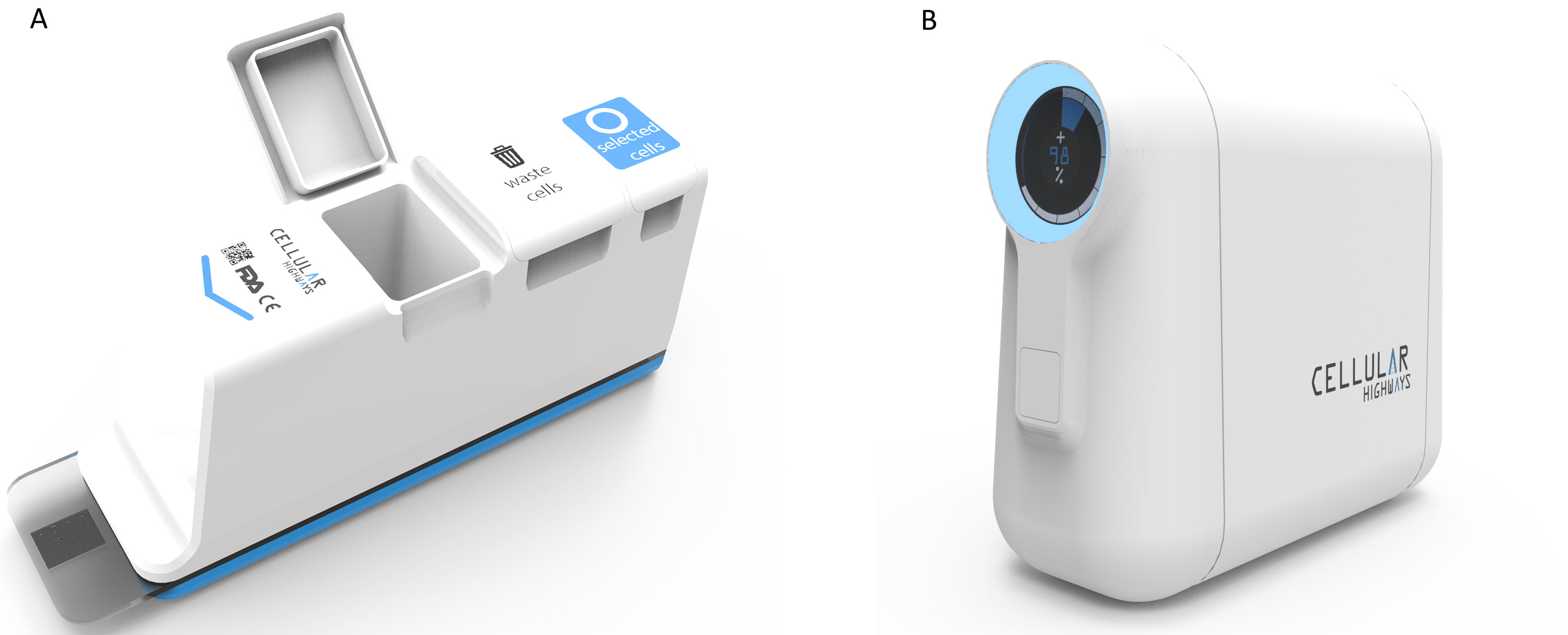Cell sorting, in particular the currently dominant jet-in-air electrostatic droplet sorting technology known as fluorescence-activated cell sorting (FACS), has enabled important advances in biology since the 1960s.
However, cell sorting is still out of reach for many users and unsuitable for some of its most valuable applications, such as cell therapy. Sorting cell batch sizes relevant to T-cell therapy, for example, requires technology that is around 10–20x faster than jet-in-air sorting.
In addition, a therapeutic cell sorter should be fully automated and safe for both operator and patient. Liquids should be fully enclosed in disposable wetted parts, and there should be no aerosols, thus eliminating the risks of contamination and cross-contamination.
Cellular Highways is a venture of The Technology Partnership (TTP) with the aim of developing a cell sorting technology that is suitable for building a therapeutic cell sorting instrument.
Faster Cell Sorting by Parallelization
In state-of-the-art equipment, cell sorting rates are limited by the physical stress of flowing through a microchannel or nozzle. This limitation can theoretically be overcome by multiplexing, i.e., by running 10–20 cell sorters, each processing 10,000 cells/s, in parallel.
But, unless the array can be made small enough, parallelization increases the cost and complexity of the optical system required for cell sorting. Each high-speed sorting device needs to fit in an array of less than around 1 mm, including actuators and plumbing, so that high sensitivity can be achieved with reasonable cost of optics. To date, not even microfluidic cell sorters have achieved this.
VACS: Vortex-Actuated Cell Sorting
The new technology achieves an equivalent droplet rate (sort envelope speed) of 43 kHz and has a footprint of 1 x 0.25 mm—including actuator. Its simple construction comprises a single microchannel that splits into two (sort and waste) and thin-film metal features on the substrate. It has no moving parts, side channels, 3D features, electromagnets, or piezoelectrics, and can be made by standard MEMS manufacturing methods.
In our technology, cell sorting is driven by a switchable microfluidic vortex stimulated by a thermal-inkjet-style actuator. By itself, the displacement created by a thermal inkjet actuator is too small and short-lived to permanently displace cells within a stream. The geometry of VACS couples the thermal vapor bubble to the creation of this tiny vortex, which amplifies and rectifies the fluid motion enough to displace selected cells (Figure 1).

Performance
We have achieved proof-of-concept results with beads, an immortal cell line, and primary human PMBCs (peripheral blood mononuclear cells), demonstrating that common and rare subpopulations can be separated with high purity and high recovery at input rates of around 10,000 particles or cells per second. We typically process around 10 million cells without blockages and only minimal build-up of debris.
So far, the technology appears to have no impact on cell viability. We are continuing to investigate viability, alongside other biological assays of T-cell activation and functionality, with a partner in cell therapy.
Next Step: Multiplex Sorting
We have started work on the next generation of our technology: a sixteen-fold multiplex cell sorter. This device will be based on the same principles but consists of 16 inertial vortex sorters in a four-by-four grid. It is expected to be faster than any fluorescence-based cell sorter yet built.
Applications
Both the single-stream and multiplex chips could be the basis of automated cell sorting instruments for research and clinical applications. Because the technology is fast and enclosed, VACS could be suitable for production of cellular therapeutics, which are currently experiencing a rapid increase in sophistication, often requiring selection (or removal) of rare phenotypes, and many cannot be made easily with any current cell separation method.

Other high-throughput research and clinical applications include single-cell diagnostics, where circulating cells need to be captured for genetic analysis, and phenotypic screening to increase the cell batch size that can practically be sorted for screening.
We have studied feasibility and cost and believe that potential instruments could be realized with moderate cost of optics and numbers and sensitivities of fluorescence channels similar to current cytometers. The cell sorting technology lends itself to automation in further ways. Fluid could be driven by a single pressure source, the chip would be aligned with the laser focus, and the delay time between detection and actuation would be scanned to find the middle of the sort envelope.
VACS could be transformative as an easy-to-use democratized research instrument for safe, aseptic cell sorting.
TTP
Cellular Highways
Melbourn Science Park
Cambridge Road
Melbourn SG8 6EE
Phone: +44 1763 262626
E-mail: [email protected]
Website: www.cellularhighways.com.


